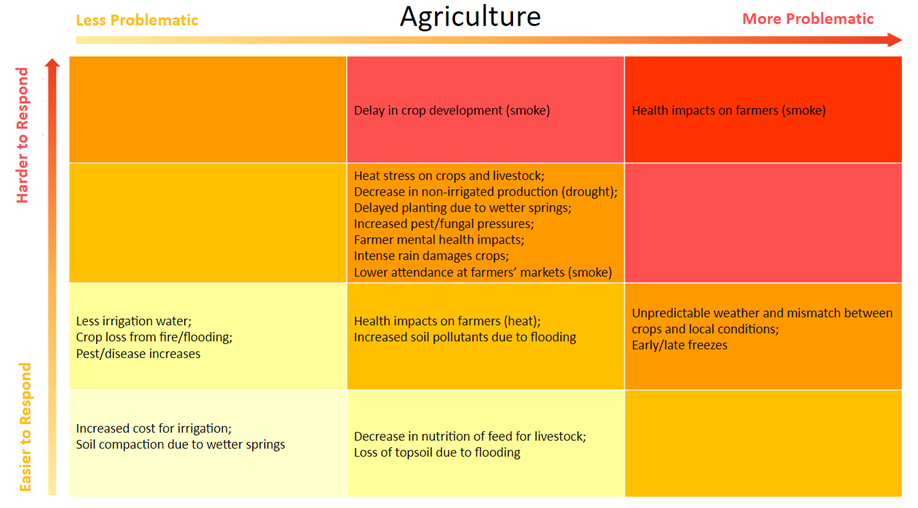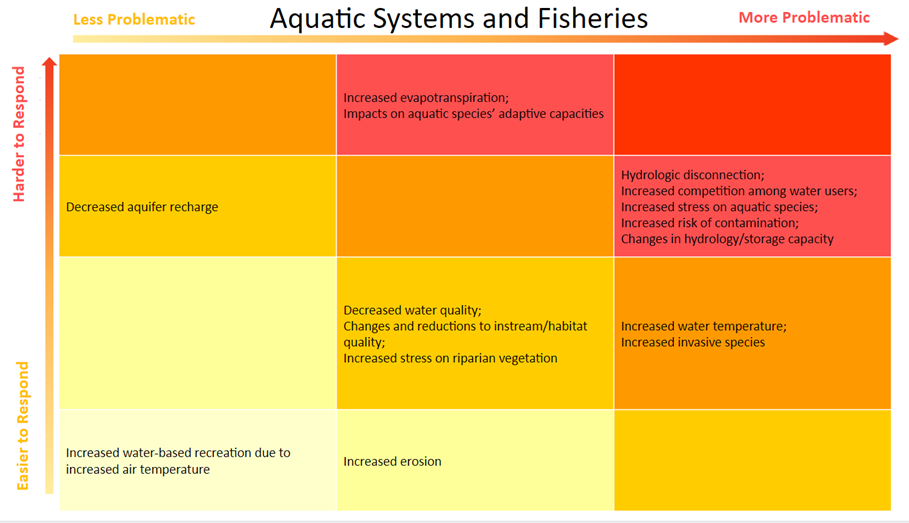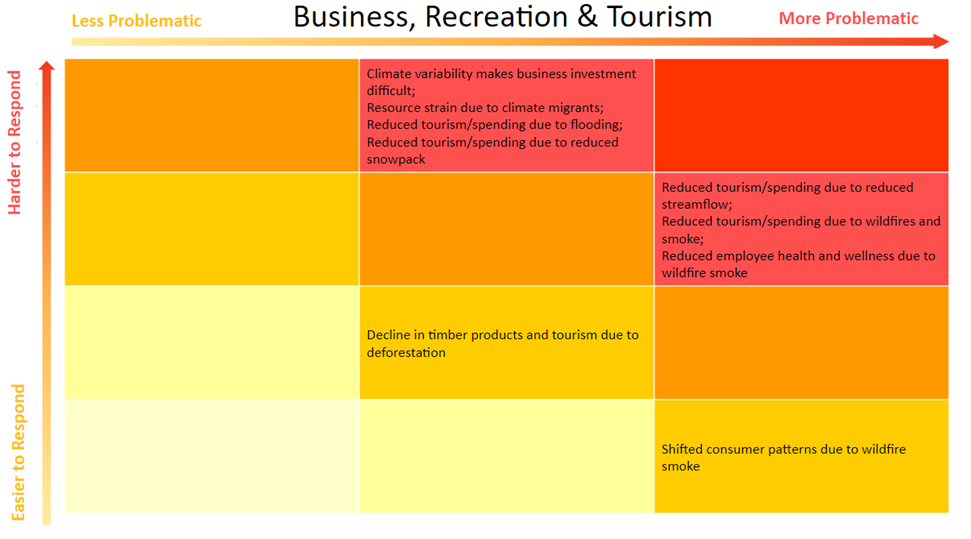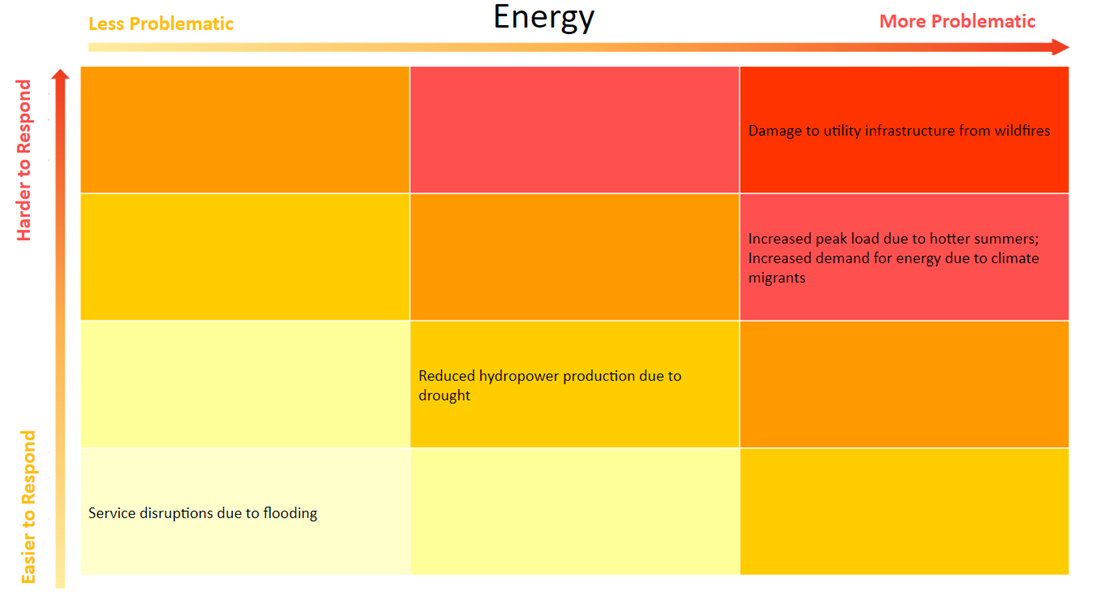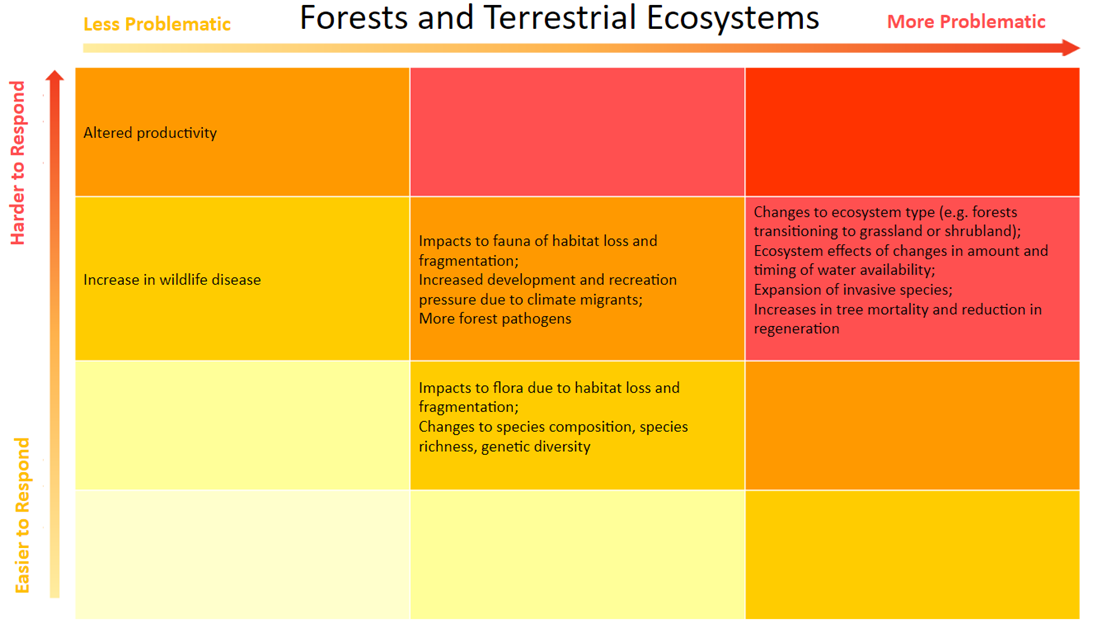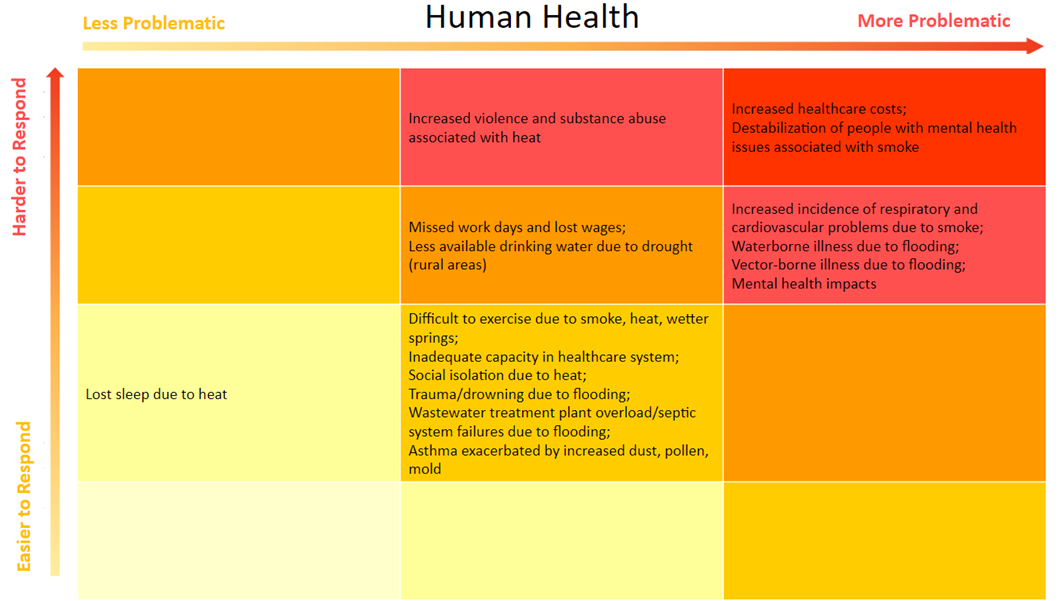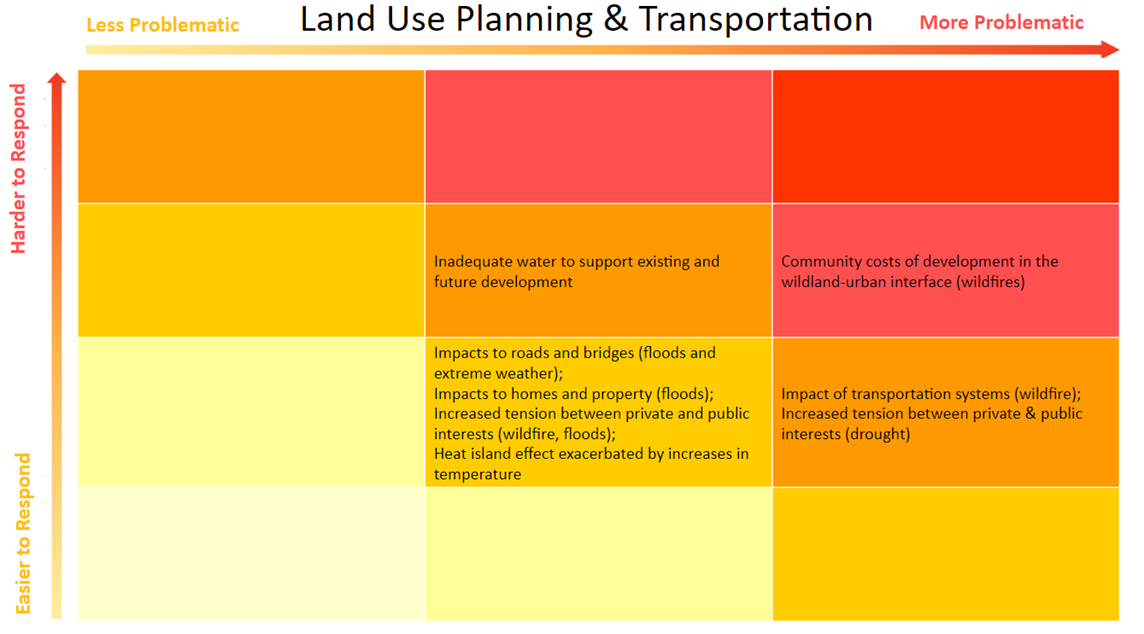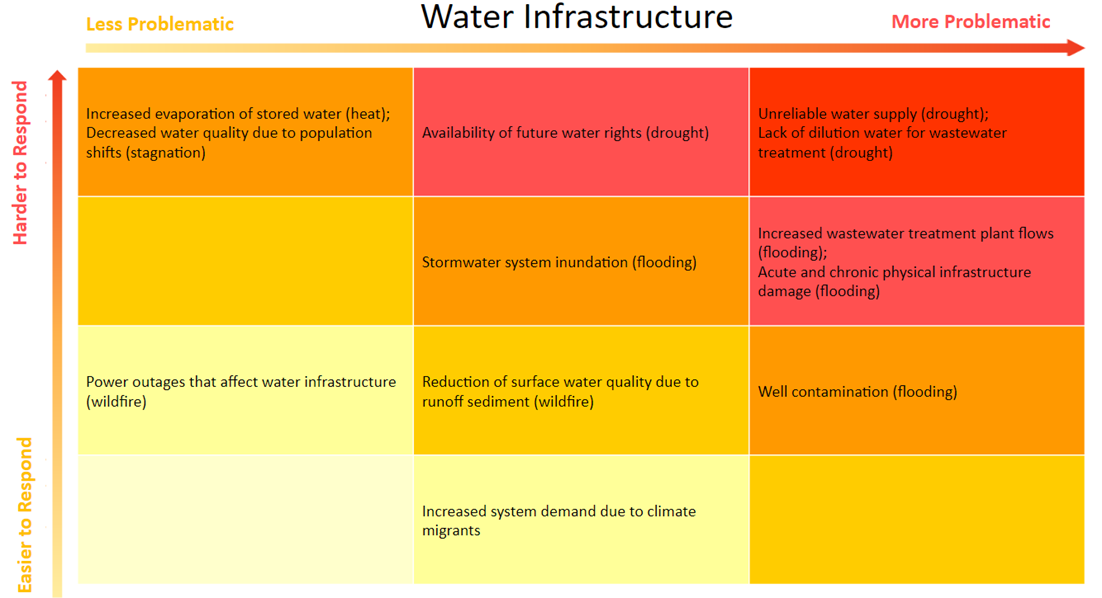There is widespread agreement that long-term droughts will be more severe when and where they do occur.
Missoula County’s total annual precipitation is projected to increase slightly as a result of climate change. However, the change in precipitation is not expected to be uniform across seasons: winter and spring are expected to be wetter and summers are expected to be significantly drier. Higher temperatures are projected to reduce low-elevation snowpack, early snowmelt, and an earlier peak in spring runoff. Over the past half-century spring runoff has shifted at least a week earlier in the northern Rockies, and this trend is likely to continue as the climate continues to warm. Earlier snowmelt and decreased summer precipitation are expected to reduce late-summer streamflows across the county.
Explore how drier summers and drought create vulnerabilities in the following sectors given climate change:
AGRICULTURE.
Longer and more intense summer droughts will most directly impact non-irrigated producers, which are a minority in Missoula County. Irrigated producers may ultimately be affected if persistent drought reduces the availability and cost of irrigation water; however, irrigation water is not currently a limiting factor for agricultural production in Missoula County, and there is significant potential to improve irrigation efficiency. Some irrigated producers will face higher electricity costs due to the need to run irrigation equipment more frequently.
Most ranchers in Missoula County are both livestock producers and crop (e.g. alfalfa/hay) producers. They typically use irrigated crops to feed their stock in the winter months, and in some cases sell the excess. Summer feed comes from mostly non-irrigated grasslands and grazing areas. Drier summers will reduce productivity of these non-irrigated grasslands, forcing ranchers to shift to irrigated croplands for summer grazing, thereby decreasing the number of animals the operation can support and/or reducing revenues from the sale of excess hay. Drought will also impact ranchers by reducing the nutritional value of non-irrigated pasture used as feed for livestock.
The full vulnerability grid for Agriculture, for all hazards, is shown below.
Most ranchers in Missoula County are both livestock producers and crop (e.g. alfalfa/hay) producers. They typically use irrigated crops to feed their stock in the winter months, and in some cases sell the excess. Summer feed comes from mostly non-irrigated grasslands and grazing areas. Drier summers will reduce productivity of these non-irrigated grasslands, forcing ranchers to shift to irrigated croplands for summer grazing, thereby decreasing the number of animals the operation can support and/or reducing revenues from the sale of excess hay. Drought will also impact ranchers by reducing the nutritional value of non-irrigated pasture used as feed for livestock.
The full vulnerability grid for Agriculture, for all hazards, is shown below.
aquatic systems.
Reduced summer streamflows together with hotter summers will lead to increased water temperatures, which are detrimental to several aquatic species, including trout, and to the recreational fishing industry that depends on healthy and robust fisheries. While native species such as westslope cutthroat trout, bull trout and Rocky Mountain sculpin are the most vulnerable, introduced game species such as rainbow trout and brown trout (which support the majority of the commercial fisheries) are also impacted.
Reduced streamflows can also lead to reduced water quality through increasing temperature and concentrations of pollutants. In turn, these conditions can enhance algae growth which diminishes the dissolved oxygen content that aquatic species rely on. Ultimately, reduced streamflows will lead to increased competition for water resources from agriculture, recreation, and wildlife, as well as domestic use in those areas of the county that rely on surface water (see Water Infrastructure). Low summer flows will also increase stress on some aquatic species by making them more vulnerable to terrestrial and aerial predators by reducing aquatic habitat diversity and protective instream features like deep pools and eddies.
Lower streamflow also means decreased groundwater recharge. While the Missoula Valley aquifer is fairly resilient compared to surface water resources, Missoula County residents outside the Missoula Valley rely on water resources that may be more vulnerable. A healthy watershed requires the lateral and vertical connection of water resources across the landscape. When water levels in rivers, lakes, and wetlands become too low, many processes that support plants, wildlife, and healthy ecosystems are hindered. This phenomenon is known as “hydrologic disconnection.” For example, when perennial streams become dewatered, fish become vulnerable to predation as a result of poor water quality and reduced habitat. Changes to vegetation (see Forests and Terrestrial Ecosystems) will also impact the hydrologic cycle; for example, trees and grasses provide shade, slow runoff, and interact with snow cover. Conversely, the hydrologic cycle impacts vegetation, forming a dynamic and important relationship.
The full vulnerability grid for Aquatic Systems, for all hazards, is shown below.
Reduced streamflows can also lead to reduced water quality through increasing temperature and concentrations of pollutants. In turn, these conditions can enhance algae growth which diminishes the dissolved oxygen content that aquatic species rely on. Ultimately, reduced streamflows will lead to increased competition for water resources from agriculture, recreation, and wildlife, as well as domestic use in those areas of the county that rely on surface water (see Water Infrastructure). Low summer flows will also increase stress on some aquatic species by making them more vulnerable to terrestrial and aerial predators by reducing aquatic habitat diversity and protective instream features like deep pools and eddies.
Lower streamflow also means decreased groundwater recharge. While the Missoula Valley aquifer is fairly resilient compared to surface water resources, Missoula County residents outside the Missoula Valley rely on water resources that may be more vulnerable. A healthy watershed requires the lateral and vertical connection of water resources across the landscape. When water levels in rivers, lakes, and wetlands become too low, many processes that support plants, wildlife, and healthy ecosystems are hindered. This phenomenon is known as “hydrologic disconnection.” For example, when perennial streams become dewatered, fish become vulnerable to predation as a result of poor water quality and reduced habitat. Changes to vegetation (see Forests and Terrestrial Ecosystems) will also impact the hydrologic cycle; for example, trees and grasses provide shade, slow runoff, and interact with snow cover. Conversely, the hydrologic cycle impacts vegetation, forming a dynamic and important relationship.
The full vulnerability grid for Aquatic Systems, for all hazards, is shown below.
business, recreation, and tourism.
The combination of reduced streamflows and higher air temperatures will lead to higher river temperatures, reducing populations of temperature-sensitive species such as bull trout and westslope cutthroat trout. Higher river temperatures will lead to more frequent fishing restrictions, with direct revenue impacts for fishing guides and outfitters and indirect impacts across the economy. Even when fishing is not restricted, warmer water impacts fishing businesses by stressing fish and therefore reducing catch rates. Multiple years of drought and warm water temperatures also increase trout mortality, reducing overall populations of catchable fish.
The transition of low-elevation forests to shrubland and grassland will affect the wood products industry since traditional sources of timber will no longer be as widely available. Opportunities for forest-based recreation such as hiking and camping will also be affected. Reduced snowpack will directly impact winter recreation activities (nordic and alpine skiing, snowboarding, snowshoeing, snowmobiling), with revenue impacts for businesses such as Snowbowl ski area near Missoula and winter gear retailers. The most significant reduction in skiable days is likely to occur in the spring, with less significant impacts in the fall. However, warmer year-round temperatures and reduced snowpack will likely expand the season for other recreational activities such as hiking, biking and fishing.
It is worth noting that the impact of climate change on tourism in Missoula County will also be affected by the relative climate impacts on outdoor recreational opportunities elsewhere in the country.
The full vulnerability grid for Business, Recreation, and Tourism, for all hazards, is shown below.
The transition of low-elevation forests to shrubland and grassland will affect the wood products industry since traditional sources of timber will no longer be as widely available. Opportunities for forest-based recreation such as hiking and camping will also be affected. Reduced snowpack will directly impact winter recreation activities (nordic and alpine skiing, snowboarding, snowshoeing, snowmobiling), with revenue impacts for businesses such as Snowbowl ski area near Missoula and winter gear retailers. The most significant reduction in skiable days is likely to occur in the spring, with less significant impacts in the fall. However, warmer year-round temperatures and reduced snowpack will likely expand the season for other recreational activities such as hiking, biking and fishing.
It is worth noting that the impact of climate change on tourism in Missoula County will also be affected by the relative climate impacts on outdoor recreational opportunities elsewhere in the country.
The full vulnerability grid for Business, Recreation, and Tourism, for all hazards, is shown below.
energy.
Drought has the potential to reduce hydropower production, which currently supplies more than half of the electricity used in Missoula County. Reduced hydropower production could result in increased use of higher-cost electricity sources, increasing costs for utilities and their ratepayers.
The full vulnerability grid for Energy, for all hazards, is shown below.
The full vulnerability grid for Energy, for all hazards, is shown below.
forests and terrestrial ecosystems.
Changes in the amount and timing of water availability, including drier summers and more intense droughts, may stress Missoula County’s forests. Lack of water will leave trees weaker and less able to fight off forest pathogens. Native flora succumbing to drought and diseases and local fauna changing their habits to cope with decreased water availability will contribute to ecosystem change. For example, lower elevation forests may transition to grassland or shrubland. The decline of overall forest health may also lead to the further proliferation of invasive animal and plant species that are better suited to drier environments. Some snow-dependent animals will shift their range due to reduced low-elevation snowpack. There may be an increased incidence of some wildlife diseases. The timber industry may be affected by reduced productivity in forest growth.
The full vulnerability grid for Forests and Terrestrial Ecosystems, for all hazards, is shown below.
The full vulnerability grid for Forests and Terrestrial Ecosystems, for all hazards, is shown below.
human health.
Longer summer droughts will lead to increasingly dry soils, increasing the likelihood of dust in the air which contributes to respiratory problems. Drought may also affect drinking water supplies in some parts of the county (see Water Infrastructure).
The full vulnerability grid for Human Health, for all hazards, is shown below.
The full vulnerability grid for Human Health, for all hazards, is shown below.
land use planning and transportation.
In rural parts of the county, existing development patterns tend to favor individual wells rather than community water systems. However, drier summers and the lack of available water rights (see Water Infrastructure section) will increasingly limit development in certain areas of the county. The more limited our water supplies become, the more tension there will be between private interests and the public good when it comes to water resources.
The full vulnerability grid for Land Use Planning and Transportation, for all hazards, is shown below.
The full vulnerability grid for Land Use Planning and Transportation, for all hazards, is shown below.
water infrastructure.
Decreased late summer water availability will result in less-reliable water supplies. Communities like Seeley Lake that rely on surface water are most vulnerable. Although the Missoula Valley aquifer is fairly resilient compared to surface water resources, many Missoula County residents outside the Missoula Valley rely on wells that draw from smaller aquifers, and these may be more vulnerable. Already, filed water rights in parts of Missoula County exceed the amount of surface water available. As a result, the state cannot approve new water rights, without proof of mitigation, in Grant Creek, Hayes Creek, the Clark Fork above the confluence of the Blackfoot River, and the entire Bitterroot River. This prohibition affects both wells and surface water draws.
Drought and drier summers may further reduce the availability of water rights in the county. However, since individual wells below established withdrawal thresholds are exempt from water right requirements, new development on individual wells may continue to occur in these areas. Droughts also reduce available dilution water for wastewater treatment effluent, potentially degrading water quality.
The full vulnerability grid for Water Infrastructure, for all hazards, is shown below.
Drought and drier summers may further reduce the availability of water rights in the county. However, since individual wells below established withdrawal thresholds are exempt from water right requirements, new development on individual wells may continue to occur in these areas. Droughts also reduce available dilution water for wastewater treatment effluent, potentially degrading water quality.
The full vulnerability grid for Water Infrastructure, for all hazards, is shown below.
